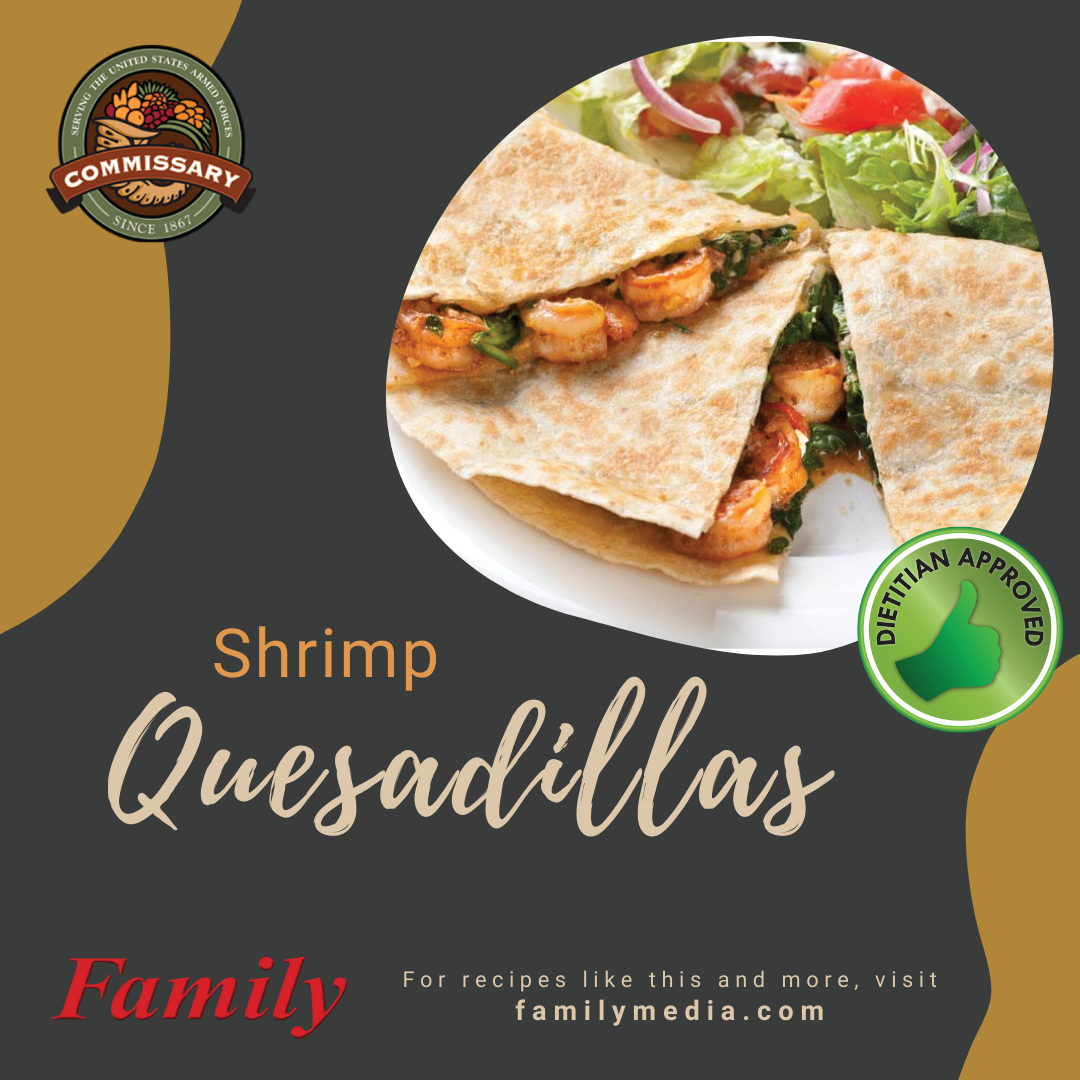It’s Worth the Trip! Shrimp Quesadillas

The USDA recommends that seafood (fish and shellfish) should be the main protein source on Americans’ plates twice a week because it contains key vitamins and minerals along with essential fatty acids (Omega 3) that are very beneficial to health. This means adults should consume approximately 4 oz. of seafood (less for young children) twice a week as part of a balanced diet to promote optimal health. It is best to meet this recommendation by consuming a variety of fish and shellfish.
In the past, Americans were advised to limit their intake of cholesterol in order to prevent and treat heart disease. As a result, certain types of seafood, high in cholesterol, like shrimp and crab were avoided. However, research has now proven that dietary cholesterol has very little impact on blood cholesterol levels and its intake does not increase the risk of heart disease.
In fact, it is truly the excessive intake of saturated fat (animal fat) that impacts blood cholesterol levels and increases the risk of heart disease. As a result, the Dietary Guidelines for Americans (DGA) no longer recommends that Americans limit their cholesterol intake too. Instead, the DGA advises Americans to focus on saturated fat consumption and limit their intake to less then 10% of their total calories for the day. For someone that needs 2,000 calories a day, this equates to keeping the total daily intake of saturated fat below 22 grams. Choosing lean protein foods, practicing portion control, and paying attention to the level of saturated fat on the Nutrition Facts label are key habits to assure that you don’t eat too much saturated fat.
Shrimp can be part of building a healthy eating style. In fact, shrimp is considered a “heart healthy” food because it is very low in fat and calories and a good source of Omega-3 fatty acids, which lowers blood cholesterol levels. A 4 oz. serving of shrimp has less than 120 calories, while providing a whopping 23 grams of protein; so, it is a great food to also use in meeting body weight goals.
This meal features two lean protein foods, black beans and shrimp. It is also loaded in complex carbohydrates and fiber to help you have lots of energy and feel full longer.
Ingredients
(Serves 4)
15 oz. black beans, drained
15 oz. whole kernel corn, drained
1/4 cup diced medium red onion
2 garlic cloves, minced
1/4 tsp. cumin
1/3 cup fresh cilantro
1 lime
1 mango
1 lb. frozen cooked shrimp
1 1/2 cups favorite cheese, shredded
2 whole wheat soft tortillas or fajita shells
Directions
To make the mango salsa, begin by draining and rinsing the black beans and corn in a colander; then, transfer to a mixing bowl.
Add the onion, garlic, cumin, and cilantro to the beans and corn; mix gently.
Cut a lime in half and squeeze the juice of both halves over the mixture and then peel and cube one mango and gently toss it into the beans. Set the mixture aside to allow the flavors to blend.
Thaw the shrimp by placing it in a colander and running cold water over it for about 5 minutes.
Cut the shrimp in half, width wise, in order to make them thinner; then, add the shrimp to 1 cups of your favorite kind of shredded cheese, and mix.
Very lightly coat one side of 2 whole wheat soft tortilla or fajita shells with olive oil.
To make a quesadilla, place 1 shell (oiled sided down) in a frying pan or skillet that has been heated over medium heat, and quickly top the tortilla with of the shrimp and cheese mixture; then, top with another tortilla (oiled side up).
Gently flip the quesadilla over when the bottom begins to brown, and cook the second side until the cheese is melted. Remove the quesadilla from the pan and repeat steps 6-8.
To serve, top each quesadilla with cup of the salsa and desired amount of chopped lettuce and tomato.
Notes
Use the remaining salsa to top salads or grilled chicken breasts.
The salsa will keep for 2 days in the fridge, so consider repeating the meal later in the week.
To add a little extra heat, add a can of green chilis to the salsa.
For other tasty recipes visit commissaries.com
Stay Connected with FamilyMedia!
Join our community! Enter your email to stay connected with Family Media.








